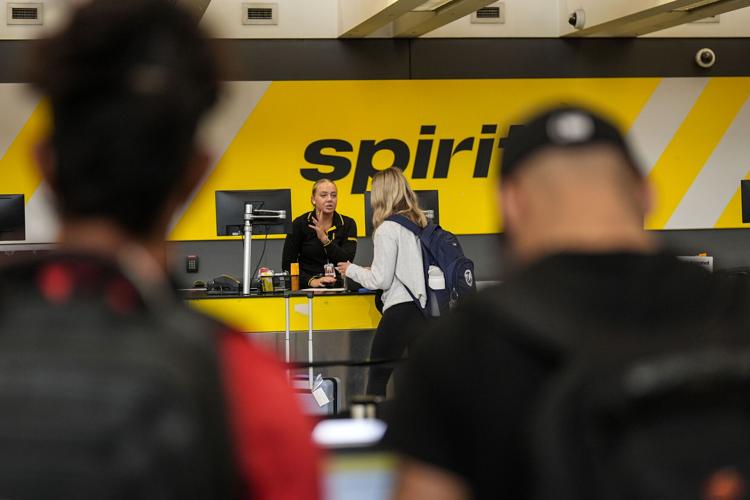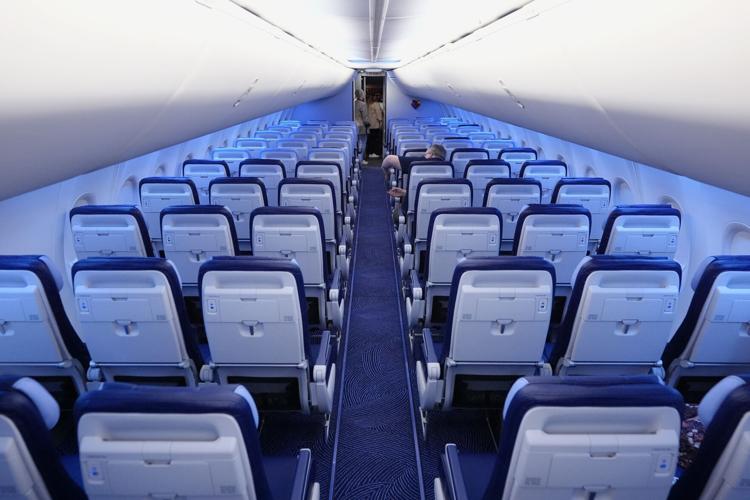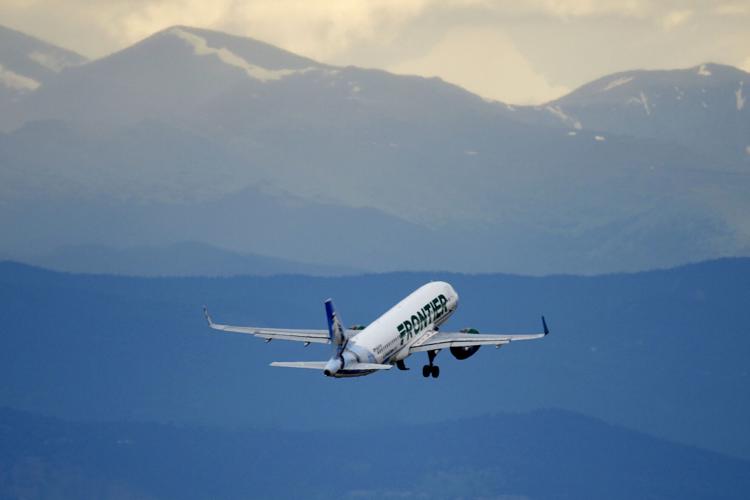DALLAS — Delta and United became the most profitable U.S. airlines by targeting premium customers while also winning back a significant share of travelers on a tight budget.
That is squeezing smaller low-fare carriers like Spirit Airlines, which recently filed for bankruptcy protection. Some travel-industry experts think Spirit’s troubles indicate that travelers on a budget will be left with fewer choices and higher prices.
Other discount airlines are on much better financial footing than Spirit, but they too are lagging far behind the full-service airlines when it comes to recovering from the COVID-19 pandemic. Most industry experts think Frontier Airlines and other so-called ultra-low-cost carriers will fill the vacuum if Spirit shrinks, and that there is still plenty of competition to prevent prices from spiking.
Spirit Airlines lost more than $2.2 billion since the start of 2020. Frontier has not reported a full-year profit since 2019, though that slump might end this year. Allegiant Air’s parent company is still profitable, but less so than before the pandemic.
Those kind of numbers led United Airlines CEO Scott Kirby to declare recently that low-cost carriers were using “a fundamentally flawed business model” and customers hate flying on them.
Kirby’s touchdown dance might turn out to be premature, but many analysts are wary about the near-term prospects for budget airlines, which charge cheaper fares but more fees than the big airlines.

A traveler speaks with a Spirit Airlines agent May 24 at Hartsfield-Jackson Atlanta International Airport ahead of Memorial Day in Atlanta.
Low-cost airlines grew in the last two decades by undercutting big carriers on ticket prices, thanks in large part to lower costs, including hiring younger workers who were paid less than their counterparts at Delta Air Lines, United and American Airlines. Wages soared across the industry in the past two years, however, narrowing that cost advantage.
The big airlines rolled out and refined their no-frills, “basic economy” tickets to compete directly with Spirit, Frontier and other budget carriers for the most price-sensitive travelers.
The budget airlines became less efficient at using planes and people. As their growth slowed, they wound up with more of both than they needed. In 2019, Spirit planes were in the air an average of 12.3 hours every day. By this summer, the planes spent an average of two more hours each day sitting on the ground, where they don't make money.
Spirit's costs per mile jumped 32% between 2019 and 2023.
Another issue is that airlines added too many flights. Budget airlines and Southwest Airlines were among the worst offenders, but full-service airlines piled on. To make up for a drop in business travel, the big carriers added more flights on domestic leisure routes. The result: Too many seats on flights into popular tourist destinations such as Florida and Las Vegas, which drove down prices, especially for economy-class tickets.

Rows of seats are shown Sept. 26 on a retrofitted Southwest Airlines jet at Love Field in Dallas.
Low-cost airlines are responding by following the old adage that if you can't beat them, join them. That means going premium, following the rapidly growing household wealth among upper-income people.
The top one-fifth of U.S. households by income added $35 trillion in wealth since 2019 and holds nearly nine times the wealth of the middle fifth, according to the Federal Reserve.
Frontier Airlines organized its fares into four bundles in May, with buyers of higher-priced tickets getting extras such as priority boarding, more legroom and checked bags. The airline dropped ticket-change or cancellation fees except for the cheapest bundle.
Spirit followed in August with similar changes, blocking middle seats and charging passengers more for the comfort of aisle and window seats.
Spirit Airlines CEO Ted Christie received a $3.8 million retention bonus a week before the Florida-based carrier filed for Chapter 11 bankruptcy. Christie will retain the bonus if he remains with the company for another year. The airline's stock has dropped over 90% this year. It has faced challenges including a blocked $3.8 billion merger with JetBlue and failed talks with Frontier. The pandemic disrupted Spirit's operations and travel patterns, reducing its daily aircraft utilization and increasing costs. Demand has shifted to full-service airlines as higher-income travelers vacation more, while inflation impacts lower-income consumers.
JetBlue Airways, which began flying more than 20 years ago as a low-cost carrier but with amenities, is digging out from years of steady losses. Under new CEO Joanna Geraghty, the first woman to lead a major U.S. airline, JetBlue is cutting unprofitable routes, bolstering core markets that include the Northeast and Florida, and delaying deliveries of $3 billion worth of new planes.
Starting next year, Southwest Airlines will toss out a half-century tradition of “open seating” — passengers picking their own seat after boarding the plane. Executives say extensive surveying showed 80% of customers preferred an assigned seat, and that's especially true with coveted business travelers.
More crowded planes also might be pushing passengers to spend more to escape a middle seat in the back of the plane.

A Frontier Airlines jet takes off July 5, 2022, from Denver International Airport in Denver.
In other parts of the world, budget carriers are doing just fine. They bounced back from the pandemic just like their more highbrow competitors.
Some industry experts say low-cost carriers in Asia and Europe have always attracted a more diverse mix of passengers, while in the U.S., affluent and middle-class travelers look down their noses at low-cost carriers.
Jamie Baker, an analyst for JPMorgan, says he has many college friends who work in London and fly Irish airline Ryanair all the time, but he hardly knows anyone who has ever been on a Spirit or Frontier plane.

A small plane tows a banner April 13, 2016, over Flint Bishop International Airport as part of ceremonies marking Allegiant Air joining the airport.
Delta CEO Ed Bastian is less dismissive of the “lower-end carriers” in the U.S. than United's Kirby.
"I don’t see that segment ever disappearing,” Bastian said after Spirit’s bankruptcy filing. “I think there’s a market for it.”
At the same time, he said the upscale moves by ultra-low-cost carriers are having no effect on his airline. Delta targets upscale travelers but also introduced basic-economy fares a decade ago, when discounters emerged as a growing threat to poach some of Delta's customers.
“Just calling yourself a premium carrier and actually being a premium carrier are two totally different things,” Bastian said “It's not the size of the seat or how much room you have; it's the overall experience.”
The most and least expensive U.S. airports to fly from in 2024
The most and least expensive U.S. airports to fly from in 2024
Updated
As frequent flyers know, air travel isn't cheap. With the summer months in full swing, demand for air travel is expected to reach record numbers in 2024 as airlines continue to recover after the COVID-19 pandemic. Luckily for those who are looking for ways to save on travel, one way to cut costs on your next vacation may be in finding the right places to fly in and out of.
FinanceBuzz looked at average domestic airfares from the 45 busiest airports in the U.S. to learn which airports are best for travelers on a budget, as well as which ones to avoid if you are trying to travel affordably.
Overall, the national average airfare cost decreased by 3.1% from 2022 to 2023 when adjusted for inflation (which translates to a 0.9% increase in non-adjusted dollars). The last time inflation-adjusted airfare costs dropped year-over-year was during the start of the COVID-19 pandemic, when it fell 18% between 2019 and 2020.
Largely, this is good news for consumers who can spend less on airfare and have more room in their budget for hotels, restaurants, and other travel fees. In addition to earning rewards on airfare, most travel credit cards offer rewards for spending in these areas, which can offset overall vacation costs.

25-year look at U.S. airfare costs
Updated
Based on Bureau of Transportation Statistics, the above chart shows inflation-adjusted average airline fares over the past 25 years.
The least and most expensive airports to fly from
For this report, we compared domestic airfares from the 45 busiest airports in the U.S. using data published by the U.S. Department of Transportation.
Least expensive airports
Updated
Orlando International Airport (MCO) had the lowest airfare cost in the country at $265.58 on average. Home to iconic theme parks like Universal Studios, Sea World, and most notably, Walt Disney World, Orlando is one of America's top tourist destinations.
This is welcome news for those bracing for expensive park tickets and food prices at the House of Mouse. Beyond saving with a Disney credit card on park-related purchases, visitors can also maximize savings by using a credit card like the Chase Sapphire Reserve which offers an annual travel credit, or even using a 0% APR credit card if you don't want to pay for your entire vacation at once.
Another Florida-based airport, Fort Lauderdale-Hollywood International Airport (FLL), has the second-lowest average airfare cost in the country — tickets here are only about $5 more expensive than Orlando's.
Just a few dollars behind FLL is Las Vegas's Harry Reid International (LAS), where fares cost $272.15 on average. LAS is also the last airport on our list where average airfare costs are less than $300.
Oakland International Airport (OAK) has the fourth-lowest average airfare costs in the country at $303.79. And the fifth-least expensive airport, Chicago Midway International (MDW), comes in at $308.27.
Most expensive airports
Updated
For the third year in a row, Dulles International Airport (IAD) and San Francisco International Airport (SFO) have the two highest average fares in the country. Flights from Dulles cost $488.40 on average in 2023, while flights from San Francisco cost $444.59.
Some silver lining for travelers who need to travel through Dulles: IAD is home to some of the best airport lounges in the country, including the recently-opened Capital One Lounge, available to Capital One Venture X or Venture Rewards credit card holders. With free food, drinks, and recharging stations, lounges can be one easy way to offset otherwise-expensive airport costs.
Salt Lake City International Airport (SLC) has the third-highest average airfare in the country, with an average cost of $438.34.
Last on our top-five list of the most expensive airports are Charlotte Douglas International Airport (CLT) and Detroit Metro Airport (DTW). Average airfare from Charlotte cost $436.80 last year, while flights from Detroit had an average price tag of $427.05.
Biggest jumps in affordability rankings
Seattle-Tacoma International Airport (SEA) was the biggest affordability winner over the last year, dropping prices by more than $18 on average. SEA jumped from 36th most-affordable place last year to 28th place this year — an increase of eight spots.
Raleigh-Durham International Airport (RDU) and Portland International Airport (PDX) experienced similar jumps, rising by seven spots each. RDU went from 24th place in 2022 to 17th in 2023, while PDX went from 42nd to 35th.
Biggest drops in affordability ranking
Two different airports fell by eight spots in our affordability rankings, tied for the biggest drop of the year. The average fare at Sacramento International Airport (SMF) rose by $18.66 year-over-year, which led SMF to go from 18th in last year's affordability rankings to 26th this year.
Prices rose even more at St. Louis Lambert International Airport (STL), going up by $19.64 on average from one year to the next. Consequently, STL fell from 21st to 29th place in terms of affordability.
How to save when you fly
As you plan your travel, you'll find costs can vary widely at a single airport. With a little research and smart planning, you can find a deal at any airport. Here are a few tips to save on airfare:
- One way to save on airfare is to use airline credit card points, or travel cards, to book your travel. For newer travelers, some welcome bonuses on beginner travel credit cards can be enough to earn you a free flight (or two).
- As we all know, flights aren't the only expensive part of traveling. Save money on baggage fees by understanding your airlines and prepping for the hidden costs of air travel.
Methodology
We looked at 2023 airfare data released by the U.S. Department of Transportation in May 2024 to compare domestic airfares by origin city. This report calculated average fares based on domestic itinerary fares.
"Itinerary fares" consist of round-trip fares, unless only a one-way ticket was purchased. In that case, the one-way fare was used. Fares are based on total ticket value, including the price charged by the airline plus any additional taxes and fees levied at the time of purchase. Fares include only the price paid at booking and do not include fees for optional services like baggage fees. Averages also do not include frequent-flyer or "zero fares" or a few abnormally high reported fares.
This story was produced by FinanceBuzz and reviewed and distributed by Stacker Media.







